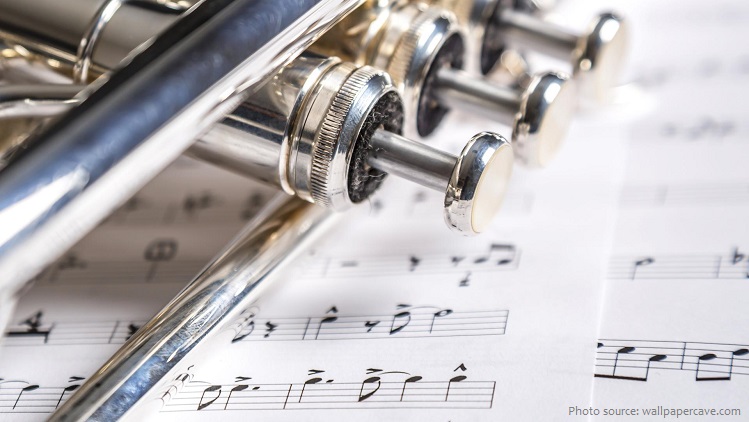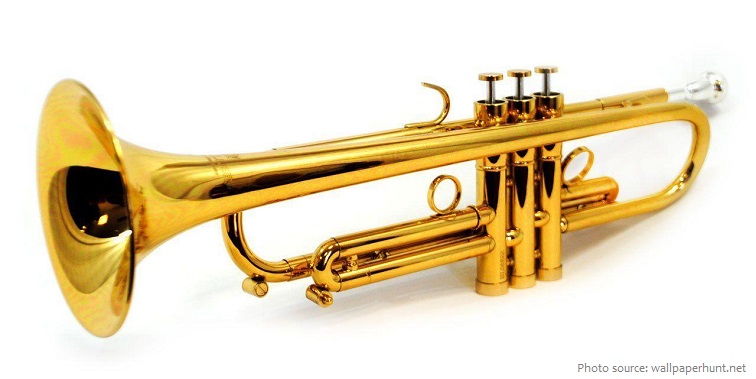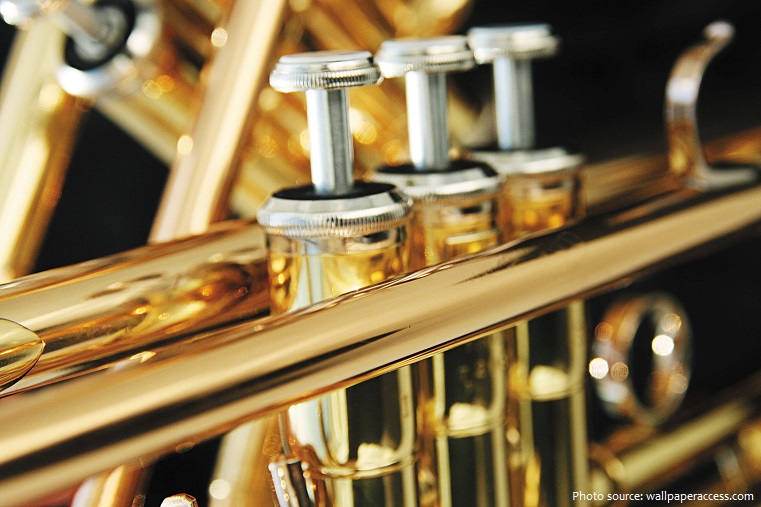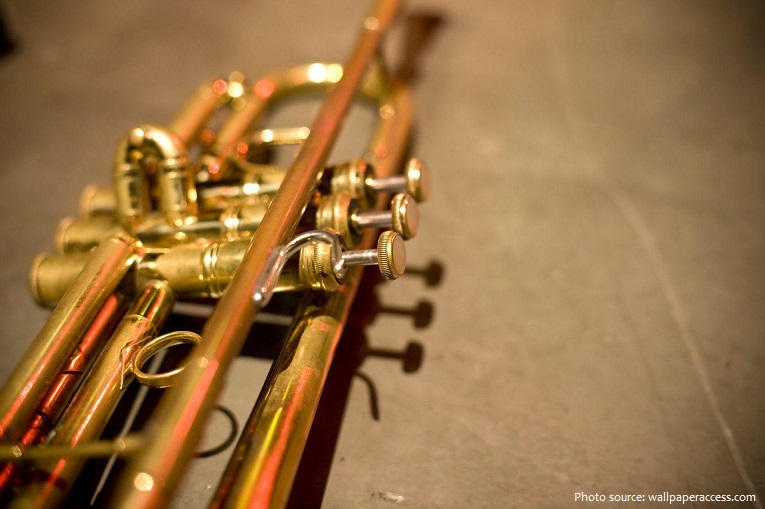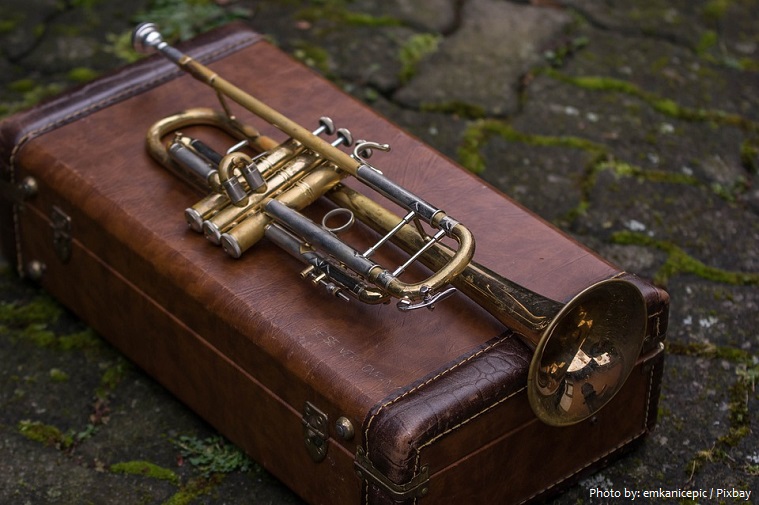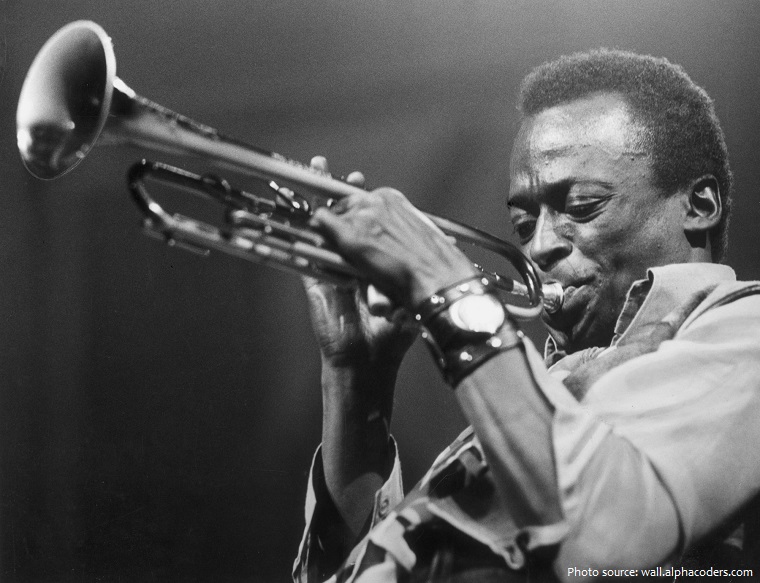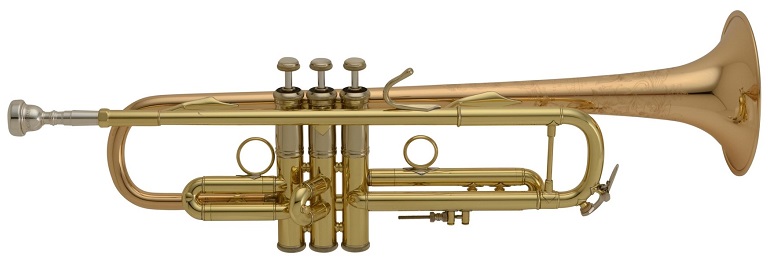The trumpet is a brass instrument commonly used in classical and jazz ensembles.
It is characterized by its striking, triumphal sound and by the fact that it boasts the highest register of all the brass instruments.
Its powerful tone is made by blowing air through nearly-closed lips, producing a sound that starts a standing wave vibration in the air column inside the instrument.
The trumpet group ranges from the piccolo trumpet with the highest register in the brass family, to the bass trumpet.
Modern trumpets have three or infrequently, four piston valves, each of which increases the length of tubing when engaged, thereby lowering the pitch. The first valve lowers the instrument’s pitch by a whole step (two semitones), the second valve by a half step (one semitone), and the third valve by one and a half steps (three semitones). When a fourth valve is present, as with some piccolo trumpets, it usually lowers the pitch a perfect fourth (five semitones).
The most common type is the B♭ trumpet, but A, C, D, E♭, E, low F, and G trumpets are also available. The C trumpet is most common in American orchestral playing, where it is used alongside the B♭ trumpet. Orchestral trumpet players are adept at transposing music at sight, frequently playing music written for the A, B♭, D, E♭, E, or F trumpet on the C trumpet or B♭ trumpet.
Like all brass instruments trumpets are almost universally made from brass, but a solid gold or silver trumpet might be created for special occasions. The most common type of brass used is yellow brass, which is 70 percent copper and 30 percent zinc.
The earliest trumpets date back to 1500 BC and earlier.
Early trumpets had a very simple shape, with just a flared bell at the end. The trumpeter could produce a number of different notes by varying his lip movement and the speed of his breath.
The bronze and silver Tutankhamun’s trumpets from his grave in Egypt, bronze lurs from Scandinavia, and metal trumpets from China date back to 1500 BC and earlier.
Trumpets from the Oxus civilization (3rd millennium BC) of Central Asia have decorated swellings in the middle, yet are made out of one sheet of metal, which is considered a technical wonder.
The Shofar, made from a ram horn and the Hatzotzeroth, made of metal, are both mentioned in the Bible. They were played in Solomon’s Temple around 3000 years ago. They were said to be used to blow down the walls of Jericho. They are still used on certain religious days. The Salpinx was a straight trumpet 160 cm (62 inches) long, made of bone or bronze. Salpinx contests were a part of the original Olympic Games.
In the ancient Greek and Roman eras, trumpets were used for marching in wartime, for which they were admirably suited. Subsequently, almost all European royalty had trumpet bands that played military music.
The Moche people of ancient Peru depicted trumpets in their art going back to AD 300. The earliest trumpets were signaling instruments used for military or religious purposes, rather than music in the modern sense – and the modern bugle continues this signaling tradition.
The Crusades of the late Middle Ages caused most of Europe to come into contact with Arabic cultures, and it is believed that these introduced trumpas made from hammered sheets of metal.
Improvements to instrument design and metal making in the late Middle Ages and Renaissance led to an increased usefulness of the trumpet as a musical instrument.
It was in the 17th century that the trumpet came to be used purely in musical ensembles. At that time, this was still the so-called natural trumpet, which can only produce natural harmonics, so the trumpet was not yet a fully functional instrument.
The modern trumpet has three valves to change pitches, added in the early 19th century.
The first trumpet factory was founded in 1842 by Adolphe Sax in Paris, and it was quickly followed by large-scale manufacturers in England and the United States.
Anton Weidinger developed in the 1790s the first successful keyed trumpet, capable of playing all the chromatic notes in its range. Joseph Haydn’s Trumpet Concerto was written for him in 1796 and startled contemporary audiences by its novelty, a fact shown off by some stepwise melodies played low in the instrument’s range.
Miles Davis (1926 – 1991) was an American jazz trumpeter, bandleader, and composer. He is among the most influential and acclaimed figures in the history of jazz and 20th-century music. Davis adopted a variety of musical directions in a five-decade career that kept him at the forefront of many major stylistic developments in jazz.
Louis Armstrong (1901 – 1971) was well known for his virtuosity on the trumpet. He was the leading trumpeter and one of the most influential artists in jazz history. Armstrong was born and raised in New Orleans.
The largest playable trumpet is 32 m (104 ft 11.84 in) long with a bell of 5.20 m (17 ft) in diameter and a 6.8-m (22-ft 3.72-in) circumference. It was achieved by Mr. Benny J. Mamoto
(Indonesia) in Tondano, North Sulawesi, Indonesia, on 31 October 2009. The trumpet can be played with the support of a kompressor.
The most expensive trumpet ever produced was the Yamaha solid platinum trumpet. The platinum makes them incredibly lightweight in comparison to conventional trumpets. The trumpet costs $125,000. Yamaha did not continue making them because there just isn’t a huge demand for $125,000 trumpets.
The English word “trumpet” was first used in the late 14th century. The word comes from Old French trompe -“long, tube-like musical wind instrument”.
Ethnologists and ethnomusicologists use the word trumpet for any lip-vibrated instrument, whether of horn, conch, reed, or wood, with a horn or gourd bell, as well as for the Western brass instrument.
The technical distinction between trumpet and horn is that one-third of the tube length of a trumpet is conical and two-thirds is cylindrical, while the horn’s tube is the opposite.

